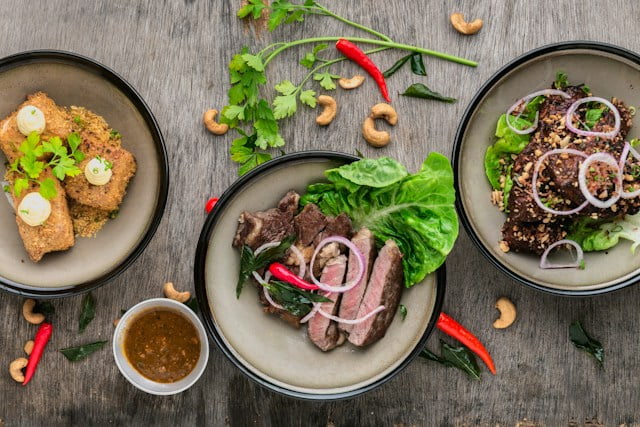
Share this post!
We all have our favorite foods that we could eat almost every day. And everyone has times when they get into food ruts, preparing some of the same meals over and over because it’s easy or we’re out of ideas. There’s nothing wrong with having some foods on repeat, especially if you’re low on time or money. But part of a healthy diet should include variety.
If you’ve ever met with a nutrition therapist, they may have underscored that diversity in what you consume can help your health. Or if you are a nutrition therapist, you may have learned this valuable principle.
But have you considered why variety in your diet is so crucial?
There are a number of reasons why, even if you eat some of the most nutrient-dense foods available, it’s important to change it up too.
What Prevents Variety in Your Diet?
For those who already like many different kinds of foods and don’t like meals on repeat, it can be confusing why this is such a big deal. Just eat lots of different things!
But there are many people who either don’t want to have to think about what to eat, only enjoy a small amount of foods or just get stuck in their ways.
The idea of meal planning can get overwhelming. And it can feel cheaper to buy large quantities of foods and just eat them again and again. Some people even have a history of disordered eating and have taken time to find the foods that they feel comfortable with.
And while these are understandable situations, finding ways to increase the types of foods you eat can actually support your health and help prevent food ruts.
Not All Vegetables are Created Equal
It’s safe to say that everyone knows they should eat lots of vegetables, some fruit and get plenty of protein. But within vegetables, within grains, within fruit, within meat and other proteins, there is a huge range of nutrients.
This means that if you eat some of the same foods over and over again without much deviation, you could be getting plenty of certain nutrients but not enough of others. This is true even if you eat at least five servings of fruits and veggies a day but they tend to be the same ones.
For example, according to the U.S. Department of Agriculture, one serving of banana has 450 mg of potassium but only 11 mg of vitamin C. Compare that with a serving of orange, which has 274 mg of potassium but 97 mg of vitamin C.
You could eat tons of bananas (although honestly, it would make you pretty constipated) and get all the potassium you need, but you might be low on vitamin C.
Similarly, carrots are rich in beta carotene (a precursor to vitamin A) at 8280 mcg in a 100 g serving but only 59 mg of vitamin C. Broccoli on the other hand contains 91 mg of vitamin in 100 g but only 93 mcg of beta carotene.

Not All Meats Are Created Equal Either
We even see these differences in meats. Although containing similar amounts of protein, ground beef contains more iron than ground chicken (1.96 mg per 100 g compared to .59 mg, respectively) as well as more zinc (3.85 mg compared to 1.18 mg, respectively). But chicken is slightly higher in phosphorus and magnesium.
If you don’t eat animal protein and you get your protein from plant sources, this becomes especially true of amino acids, which vary greatly by foods. It’s important to get all the essential amino acids but if you don’t vary your diet, you may get plenty of certain amino acids but not enough of others.
Mixing and rotating between grains like quinoa and amaranth, seeds like hemp and chia, and legumes like beans and chickpeas can help you hit that sweet spot of getting all the essential amino acids.
Avoiding Food Sensitivities
A few years ago, my husband was having gastrointestinal issues and he was interested in doing an elimination diet to help determine if he was suffering from food sensitivities. When I gave him the list of foods we would try cutting out, he balked at gluten.
“I can’t be allergic to gluten,” he argued. “I eat a peanut butter and jelly sandwich for lunch every single day.”
This was when I had to point out to him that eating that same lunch so consistently may have actually been a factor in what did end up being a gluten sensitivity, as revealed by the elimination diet.
When we eat the same foods in constant rotation, we may increase the risk of those foods triggering an immune response in our gut.
Although these foods may not have triggered a response despite years of consuming a food, a new sensitivity can show up at any time, especially in cases of leaky gut.
When there is inflammation in the lining of the gut, the junctions between cells can allow larger particles into the bloodstream, where they don’t belong. Once there, the immune system may see these unbroken-down food particles as a threat and initiate an attack, causing the symptoms of food sensitivities.
The more a certain food is eaten over and over again, the more likely it is to get through that barrier and trigger an immune response.
By varying what you eat, you can reduce the risk of triggering food sensitivities. This type of rotation can also allow the junctions to start to improve, thereby allowing some once triggering foods to be reintroduced. Some practitioners even recommend a 4-day food rotation for gut healing, meaning a food is only eaten once at least every four days.
Varying Foods is Easier than Eliminating Foods
Eliminating foods that may not work well for you can be difficult and feel restrictive. But if you aim to rotate through foods and therefore create a lot of variety in your diet, it may work to have certain foods occasionally.
This is especially great for anyone with disordered eating tendencies. The idea of only eating certain foods once in a while in a larger diet that includes lots of options can feel better than completely eliminating a food.

A Varying Diet is a Beautiful Diet
Besides all the practical and scientific reasons to make sure your diet has variety, there is just how much more fun, delicious and beautiful that diet can be.
When you allow yourself, or even push yourself, to not eat the same things over and over, you increase the chance to finding new favorite foods. You get to try dishes from other cultures and countries. And you experience different flavors each day and throughout your day.
So try a different grocery store like a Korean market. Pick up a new cookbook from the library with recipes you’ve never made before. Sign up for a CSA that will include fruits and vegetables you’ve never cooked with.
If you approach variety as an opportunity and not as a chore, it can make your diet and your life just a little more exciting.
Want to try some new delicious dishes that may take you outside your comfort zone? Try this Thai Broccoli Fish Stew or this Moroccan Chicken with Olives and Apricots.
Are you inspired by nutrition and want to help people add variety to their diet? Then becoming a Nutrition Therapist Master is the perfect way to do just that! Our Nutrition Therapist Master Certification is science-based and the most comprehensive nutrition training program available today. Get in touch with our admissions team to learn more today!
About the author: Maya Strausberg earned her Master Nutrition Therapist certification from NTI before starting her nutrition therapy private practice. She now offers writing and editing services for nutritionists and other health practitioners around the world through her business, Family Tree Nutrition.
Images: Photo by Anna Pelzer on Unsplash; Image by Benjamin Davies from Pixabay; Photo by Lily Banse on Unsplash
Share this post!




















